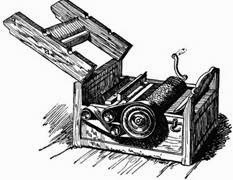Georgia After the Revolution
 |
| The Cotton Gin |
Next: SALMA(The order of Georgia's capital cities)
1. Savannah
2.Augusta
3. Louisville
4. Milledgeville
5. Atlanta
How did Georgia handle land?
1. The Headright System: Land was given to the head of each household
2. Land Lotteries: Residents could win land likely previously owned by natives
3. Yazoo Land Fraud: A major scandalous land sale, where Georgia sold land for ridiculously low prices, in turn losing land in Mississippi and Alabama
 As far as Native lands, McGillivray and McIntosh differ greatly although they are both Native Americans themselves. McGillivray fought against Georgia trying to keep Creek land whereas McIntosh sold the last of the Creeks' land and was killed by his own people for it. In addition, John Ross led his people, The Cherokee, along The Trail of Tears and was their chief and supported them during Worchester vs. Georgia. In the court case, Worchester vs. Georgia, John Marshall, supreme court justice, ruled that the Native Americans could remain in Georgia, however, Andrew Jackson responded with rejection and neglect making his famous reply," John Marshall has made his decision; now let him enforce it!" We all know though that it is the executive branch's job to enforce jurisdictions and laws. Sadly, The Indian Removal act of 1830 by Andrew Jackson removed all Native Americans despite much disapproval. Finally, the Indians were relocated to Oklahoma, but many died along the way on the tough journey.
As far as Native lands, McGillivray and McIntosh differ greatly although they are both Native Americans themselves. McGillivray fought against Georgia trying to keep Creek land whereas McIntosh sold the last of the Creeks' land and was killed by his own people for it. In addition, John Ross led his people, The Cherokee, along The Trail of Tears and was their chief and supported them during Worchester vs. Georgia. In the court case, Worchester vs. Georgia, John Marshall, supreme court justice, ruled that the Native Americans could remain in Georgia, however, Andrew Jackson responded with rejection and neglect making his famous reply," John Marshall has made his decision; now let him enforce it!" We all know though that it is the executive branch's job to enforce jurisdictions and laws. Sadly, The Indian Removal act of 1830 by Andrew Jackson removed all Native Americans despite much disapproval. Finally, the Indians were relocated to Oklahoma, but many died along the way on the tough journey.Dahlonega Gold Rush
The second largest gold rush in the U.S. this event caused a great ripple in Georgia's history. It began in 1828 near Lumpkin County, Georgia, however, by the early 1840s it started to get harder to find. Then as gold began to be found out in California in 1848, Georgia miners started moving west.
For more information visit: http://www.todayingeorgiahistory.org/content/dahlonega-gold-rush
http://www.todayingeorgiahistory.org/content/worcester-v-Georgia
http://www.todayingeorgiahistory.org/content/john-ross
http://www.todayingeorgiahistory.org/content/eli-whitney
http://www.todayingeorgiahistory.org/content/william-mcintosh
(Sources):
http://0.tqn.com/d/geology/1/0/m/_/1/GAdahlonegamine.jpg,http://coolkidlit-4-,socialstudies.pbworks.com/f/1223350818/the_trail_of_tears.jpg, http://etc.usf.edu/clipart/7800/7804/cottongin_7804_lg.gif
 |
For more information visit: http://www.todayingeorgiahistory.org/content/dahlonega-gold-rush
http://www.todayingeorgiahistory.org/content/worcester-v-Georgia
http://www.todayingeorgiahistory.org/content/john-ross
http://www.todayingeorgiahistory.org/content/eli-whitney
http://www.todayingeorgiahistory.org/content/william-mcintosh
(Sources):
http://0.tqn.com/d/geology/1/0/m/_/1/GAdahlonegamine.jpg,http://coolkidlit-4-,socialstudies.pbworks.com/f/1223350818/the_trail_of_tears.jpg, http://etc.usf.edu/clipart/7800/7804/cottongin_7804_lg.gif
No comments:
Post a Comment